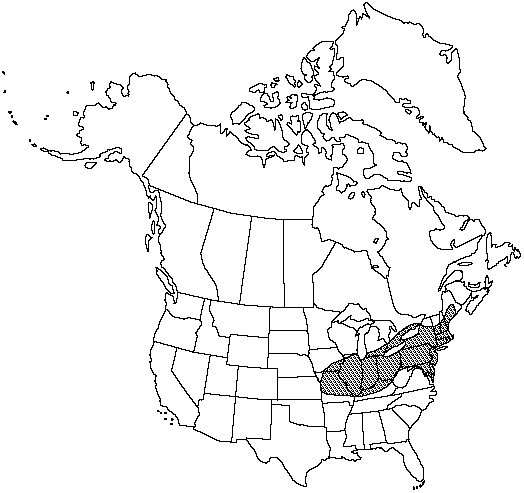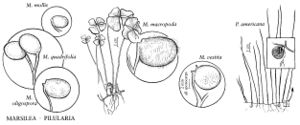Marsilea quadrifolia
Sp. Pl. 2: 1099. 1753.
Plants forming diffuse clones. Roots arising at nodes and 1–3 on internodes. Petioles 5.4–16.5 cm, sparsely pubescent to glabrous. Pinnae 7–21 × 6–19 mm, sparsely pubescent to glabrous. Sporocarp stalks ascending, frequently branched, attached 1–12 mm above base of petiole; unbranched stalks or ultimate branches of stalks 3–16 mm; common trunk of branched stalks 1–4 mm (rarely 2–3 unbranched stalks attached separately to same petiole). Sporocarps perpendicular to ascending, 4–5.6 × 3–4 mm, 2.3–2.8 mm thick, rounded, oval, or elliptic in lateral view, pubescent but soon glabrate; raphe 1.4–1.9 mm, proximal tooth usually absent, distal tooth absent or 0.1–0.2 mm. Sori 10–17.
Phenology: Sporocarps produced summer–fall (Jun–Oct).
Habitat: On mud and in shallow water.
Distribution

Introduced; Ont., Conn., Ill., Ind., Iowa, Ky., Maine, Md., Mass., Mich., Mo., N.J., N.Y., Ohio, Pa., se Europe, Asia
Discussion
Marsilea quadrifolia was introduced in Connecticut about 1860. Many of the localities from which it is known at present are artificial bodies of water. This may indicate intentional introduction of the plant as a curiosity.
Because its leaves are glabrous to essentially glabrous, Marsilea quadrifolia is unlikely to be confused with any other Marsilea in the flora. Likewise, the petioles of the land leaves in this species tend to be procumbent rather than stiffly erect as in the others. The branched sporocarp stalks found in M. quadrifolia are found elsewhere only in M. macropoda; the latter, however, is a hairy plant and has no distal tooth on the very large sporocarp.
Marsilea minuta Linnaeus, a widespread species in the paleotropics, has recently been collected from the Florida Panhandle. It resembles M. quadrifolia in having roots both at the nodes and on the internodes and in having relatively glabrous land leaves, but it has sporocarps that are only 1.3–1.7 mm thick, with a distal tooth 0.3–0.6 mm long. Marsilea minuta also has a tendency for the terminal margins of the land leaves to be crenate rather than entire.
Selected References
None.
